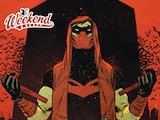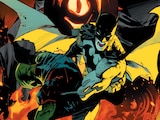Batman likes to stick to the shadows, completely silent and unseen. Eventually, he’ll strike, but until then, he remains hidden from anyone looking for him.
Interestingly, you can say the exact same thing about many of his best stories. Oh sure, you know where to look for classic Batman tales like THE DARK KNIGHT RETURNS, HUSH and THE KILLING JOKE. But there are quite a few excellent Batman comics hidden in places you might not think to look. These stories won’t be found in the pages of BATMAN or DETECTIVE COMICS, or in graphic novels with Batman in the title, but they feature the Dark Knight in compelling, crucial ways.
Below, you’ll find five of our favorite “hidden” Batman stories along with where to look for them. To start, we’re heading to the Watchtower.

 THE TOWER OF BABEL
THE TOWER OF BABEL
Like all Justice League members, Batman will occasionally take center stage in a JLA story. But arguably, none of these has been as effective, shocking or defining as this story from Mark Waid, Howard Porter and Steve Scott. Initially running in JLA #43-#46, “The Tower of Babel” finds Batman nemesis Ra’s al Ghul attempting to bring down civilization by destroying mankind’s ability to communicate. However, to have any chance at success, he must first incapacitate the Justice League, which he does by ruthlessly targeting each member and taking advantage of their individual weaknesses.
While seeing the Justice League brought down one-by-one is unsettling, the real shock is in where Ra’s al Ghul learned how to take them down—Batman’s secret files. The ideas for the traps Ra’s set were all stolen from Batman, who secretly created them as protection against a Justice League gone rogue.
One of Batman’s greatest strengths as a hero is his preparedness, but “The Tower of Babel” questions when that preparedness becomes a violation of trust. It gets to the heart of Bruce’s tendency to sacrifice relationships in favor of efficiency and suggests that even when the stakes are at their greatest, winning matters less than how you win.
“The Tower of Babel” is collected in JLA VOL. 4 and was also adapted into an equally good animated film, Justice League: Doom.

 SOFT TARGETS
SOFT TARGETS
Written by the dream team of Greg Rucka and Ed Brubaker and drawn with gritty realism by Michael Lark, GOTHAM CENTRAL focused on the good and not-so-good cops of the GCPD and their often contentious relationship with the city’s darkly-clad hero. In the tense “Soft Targets,” the Joker goes on a shooting spree a few days before Christmas, targeting some of the city’s public figures, as Commissioner Akins (this series was set during Jim Gordon’s temporary retirement), Crispus Allen, Renee Montoya and the rest of the GCPD frantically try to figure out where he’ll strike next.
“Soft Targets” is essentially a Batman and Joker story told from a very different point of view, where the Dark Knight plays more of a supporting role. But it’s still very much a Batman story. When the GCPD discover a cryptic note that the Joker left behind in one of his sniper nests, it becomes clear that these murders are just his latest way of taunting Batman, with the police and the people of Gotham caught in the middle. The story also reveals the unhealthy reliance that Gotham has on the Dark Knight. At one point, the mayor demands the GCPD roust a gang of uninvolved Joker acolytes (making sure it’s in front of news crews) despite the fact that it would remove precious officers from the actual case because he’s sure Batman will eventually be the one to find the Joker.
Perhaps more than any other story, “Soft Targets” effectively illustrates the human cost of Batman’s unending battle with the Clown Prince of Crime and gives weight to the argument that many of the crimes he prevents, he also provokes. And it’s a pretty solid cop story to boot. “Soft Targets” got started in GOTHAM CENTRAL #12, and is collected in GOTHAM CENTRAL BOOK TWO: JOKERS AND MADMEN.

 SEEING RED
SEEING RED
Coming near the end of writer Judd Winick’s run on GREEN ARROW, “Seeing Red” reads as a potent follow-up to Winick’s iconic UNDER THE RED HOOD. In this four-issue yarn, an arms deal brings Red Hood to Star City with Batman in pursuit, forcing Green Arrow to reluctantly team up with the Dark Knight. This is Jason Todd in full-on antihero mode, and still furious over what happened to him. He’s a genuine threat…but not to Batman. Rather, he chooses to make a point to his former mentor by kidnapping Green Arrow’s sidekick, Speedy.
Winick has some real fun contrasting Batman and Green Arrow—two characters who are often seen as very similar—and clearly illustrating the differences between the two. But what really makes this story effective is that he does this while also pointing out the similarities that Mia Dearden has to Jason Todd—who makes a powerfully effective case on the necessity of extreme measures to her. While Ollie and Bruce manage to save Mia, it’s hard to see them as the winners in this story.
For fans looking for something to read after Under the Red Hood, “Seeing Red” may be just what you’re looking for. The easiest way to read this one is digitally—it kicks off in GREEN ARROW #69 and wraps us in issue #72.

 POST-CRISIS
POST-CRISIS
This one is admittedly more of a hidden Batman scene than it is a full Batman story. However, the character work in the scene’s few pages is so perfect that we had to include it. “Post-Crisis” is a Geoff Johns and Howard Porter one-shot that appeared in THE FLASH #217 and came out in the wake of IDENTITY CRISIS. At first glance, it may seem an odd addition to this list since the bulk of the story looks at how the Rogues mourn the death of Captain Boomerang. But it turns out they’re not the only ones grieving, as we see when Batman confronts Wally West about the murder of Tim Drake’s father at the hands of Boomerang.
Since the scene is only a few pages long, we don’t want to reveal too much of what’s said between the two heroes. However, the exchange manages to illustrate the difference between Batman’s rogues’ gallery and the Flash’s, while also making clear just how much responsibility and, yes, love Bruce feels for the people he takes in. If you don’t already have this back issue in one of your longboxes, the best way to read this story is digitally. Also, while it’s not necessary to have read Identity Crisis to still enjoy “Post-Crisis,” we’d recommend it.

 DARK NIGHT: A TRUE BATMAN STORY
DARK NIGHT: A TRUE BATMAN STORY
Is Batman real? For most people, the response to that question is likely a clear, “No.” However, Paul Dini and Eduardo Risso’s powerful graphic novel suggests that perhaps the answer is more complicated than that.
As a Vertigo title, you’re not likely to find the autobiographical DARK NIGHT: A TRUE BATMAN STORY alongside the other Batman graphic novels, but if you’re a Batman fan, it’s unequivocally worth tracking down. While Batman: The Animated Series was at its most successful, Dini’s life was both figuratively and literally shattered when he was the victim of a brutal late night mugging. The crime and his painful recovery caused Dini to question all aspects of his life, but particularly his work. After all, what’s the value of telling Batman stories when the moment he really needed Batman in his life, the hero was nowhere to be seen?
But this isn’t just a comic about someone who worked on Batman—it’s a Batman story. Dini possesses a vivid imagination, and as he explains it, the fictional characters he loves have always been alive in his mind. As he tries to make sense of the attack, his negative thoughts take the shape of some of Batman’s most famous villains—Penguin, Two-Face, Poison Ivy, Scarecrow and particularly the Joker. We’ve seen Dini write these characters before, but Dark Night offers him a chance to write them in an entirely fresh way. The villains are often inviting and understanding, trying to lure Dini down an unhealthy path that will ultimately lead to self-destruction, while Batman offers up tough encouragement that Dini isn’t always inclined to take.
The use of the characters is clever and speaks to Dini’s thorough understanding of them. It also suits a story which suggests that in a harsh, unfair world, entertainment can hold a profound importance, and that Batman—even if it’s not how you would expect—can save you.
These are five of our favorite “hidden” Batman tales, but they’re definitely not the only ones to be found. Is there a good Batman story that you’ve uncovered that didn’t actually appear in a Batman comic? Let us know about it below!




















